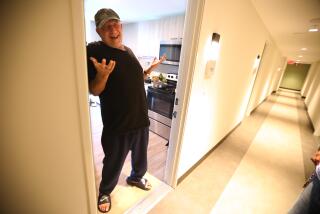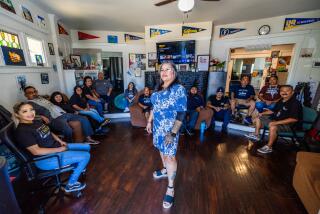SPECIAL REPORT: The Downtown Drop-In Center allows homeless people to shower and catch a little sleep. Advocates welcome the effort, but the huge numbers have meant problems. : A Skid Row Refuge, but Is It Enough?
- Share via
On a narrow, isolated stretch of San Julian Street in downtown Los Angeles, homeless people by the hundreds are flocking to use a new city-sponsored drop-in center that offers them something unique: a hassle-free place to shower, launder their clothes and sip a cup of coffee.
The Downtown Drop-In Center is so popular that the 250 people who were expected to use the facility each day has quickly been outstripped: It has drawn as many as 1,200 in a day and averages more than 800 daily walk-ins who overflow its Mediterranean-style courtyard and the street beyond.
Some people say the center has been a lifesaver, helping to pave the way to jobs and better health. But the huge numbers have also meant huge problems that have sparked yet another debate over how best to deal with a skid row homeless population that numbers more than 22,000, many of them beset with drug and alcohol addictions and mental illnesses that defy conventional solutions.
The 24-hour drop-in center was opened six months ago with high hopes and the backing of Mayor Richard Riordan and other civic leaders as an experimental new approach: a high tolerance facility catering to the kinds of hard-core street nomads who would normally be unwilling to visit conventional shelters, or who had been banned from them because of disruptive behavior.
Services would be provided with no quid pro quos such as the prayer meetings common at nearby missions. There would be a minimal security presence and even the most disheveled-looking would not be harassed or looked down on. But the center quickly became a central meeting place not only for street people, but for shelter dwellers and residents of surrounding single room hotels.
And somehow word went out that it was a place where anything goes. Along with the poor souls looking for a shady spot to rest came the predators ready to roll them for government checks or to solicit them as drug runners in exchange for dope. People were openly selling heroin in the courtyard and shooting up in the restrooms, according to police.
It didn’t help that private security patrols in the surrounding toy and fashion districts began herding homeless people off the street and in the direction of the center. Officers with the Los Angeles Police Department’s Central Division said they had to intervene with the patrols when foot traffic began to overwhelm the center.
The Volunteers of America, which manages the 8,500-square-foot, single-story structure, has had to hastily reevaluate its mission and programs to accommodate the crush. Some of the problems have abated but some remain.
To supporters and detractors, the drop-in center is either a long-awaited godsend or a dangerous, overcrowded no man’s land in a part of downtown that already fills many who venture into it with trepidation.
“The center is an extremely important asset in the skid row area,” said Harold Adams, executive director of the Los Angeles Homeless Services Authority, which has oversight of the facility. “There were some initial problems just because of the volume of traffic they had and it took them a while to set up the necessary adjustments. It’s been a learning curve for everybody. . . . But we’re making substantial progress in stabilizing the center and making it a workable place.”
Officials with the Volunteers of America admit they were blindsided by the numbers.
“It didn’t turn out quite the way we intended,” said center director James C. Howat. “But we believe we should be customer driven and we’ve tried to accommodate everyone.”
The center provides job development, self-help groups, literacy classes and personal mentors but has become far more of a multipurpose affair in order to cater to a more diverse population. Trips are arranged to help people get identification cards and government benefits such as Supplemental Security Income.
It is the quotidian aspects of the center that attract many homeless people. There are 32 respite beds in a cool interior section of the building where men and women can catch a nap during eight-hour shifts. There are men’s and women’s showers next to the laundry. A clubhouse features a television and video equipment for movies. Outside in the courtyard are tables for chess and a barbecue.
Howat said the center has increased staffing--currently about 43 paid positions--by 25% and will add more in coming months. The group dismantled a retaining wall it had built near a row of hedges across San Julian because it was being used as a gathering point for drug sales.
Curbs in front of the building were made No Parking zones and sidewalks and the street are swept clean several times a day to discourage drive-by drug dealing. The group has also cooperated with police in erecting an observation post in the building that is manned several times a week.
But Howat said his group has only had to eject about a dozen people and there have been few violent incidents.
Some criticism of the center’s operation is motivated by a dislike of its undemanding, live-and-let-live approach with the homeless who use it, said Volunteers of America CEO Robert Pratt.
That laissez faire attitude stems from a philosophy called health realization, a New Age-sounding concept that holds that even people living in the direst of circumstances possess an innate sense of well-being that can be unlocked. The goal of the program is to assist self-destructive or hostile people to rediscover their value and potential by stressing the positive rather than viewing them as victims.
Developed by a pair of academics, the concept has gained ground in recent years and is now used in housing projects, jails and schools nationwide, with backing from the departments of Justice and Housing and Urban Development.
Although the health realization model has met with skepticism from some homeless advocates, its novel approach is what appealed to Los Angeles officials who had been searching for new ways to reach the most unmanageable street people.
“We get criticized by our colleagues, but a lot of them wouldn’t let most of these people in the front door,” Pratt said.
Many who have visited the center say it has helped improve their lives. Before Robert Cleitt drifted there, he seemed a lost cause even to himself. The 37-year-old Los Angeles native said he had been in and out of prison on drug charges and for once assaulting his brother.
Drug-addled and belligerent, he would threaten the center staff, cursing them and anyone else with the temerity to get in his face. But instead of being turned away, he was welcomed and patiently counseled. A transformation began to take place. He got into a detox program and for once stuck with it.
“I got unconditional love there,” said Cleitt. “They gave me hope and self-esteem, some tools to work with.”
He lives in a recovery house now, is working, and credits the center with restoring his sense of humanity. But Cleitt says he turned down a job at the center so he could get out of downtown and to a safer place.
The drop-in center has exposed rifts among homeless advocates.
“Early on it was an oasis where you could go and hang out under a palm tree. But now it’s like the Wild, Wild West,” said Pete White, an organizer with the Los Angeles Coalition to End Homelessness and Hunger.
Alice Callaghan, a long-time skid row activist who vociferously opposed the center, agreed.
“If you rely on the assumption that these are people who don’t want rules, then you’re going to invite danger,” Callaghan said. “They’re providing some much appreciated services in the neighborhood, but it’s not quality services. If you’re going to do showers, why not do a lot of showers in a place that is well-managed where people feel safe.”
But other homeless advocates say the benefits have outweighed any problems.
“The overwhelming numbers flocking to the center speak to the great need in the area,” said Zelenne Cardenas, director of United Coalition East, an alcohol and drug prevention program that operates in skid row. “It’s done a tremendous amount of good in the area and I think we need a couple more like it.”
Cardenas and other advocates also say that the center has to contend with a decades-long city policy of centering homeless services in a small section of downtown that came to be known as skid row. It is defined as roughly a 50-block area bounded by 5th, San Pedro, Main and East 9th streets. Over the years, the area has become a dumping ground for all of the county’s down and out.
Connie Tyson, a program manager at the drop-in center, said parole officers routinely ask her if they can drop newly released prisoners at the center.
“I question why anyone would want to release a parolee here when the high probability is he will end up back in jail,” she said.
Lt. Ken Hillman, a Central Division detective, said an estimated 1,500 parolees reside in skid row. Many no doubt are trying to get back on their feet. But others like being downtown because they can blend in and more easily prey on people with few defenses.
At a recent meeting with sheriff’s officials, Hillman said he was aghast to learn that the downtown men’s jail releases an average of 30 mentally ill people each day who have been picked up from all over the county. Most of them end up on skid row.
“There is no system to transport them back to where they came from,” Hillman said. “How do we revitalize downtown when we get problems transported to us from all over the county?”
Hillman is uniquely positioned to assess both the positive and negative aspects of the center. The Los Angeles native has a degree from Cal State Dominguez Hills and wrote a thesis about shelter-resistant homeless people, studying conditions in Los Angeles, New York and other cities. And he has personally experienced the pain of a family member addicted to drugs.
The drop-in center, while worthy, has moved the problems from one street to another, Hillman said. Some of his ideas make homeless advocates blanch. He wants to more vigorously enforce public nuisance laws against graffiti, urinating in public and other misdemeanors. But he also favors the concept of a community court and of sending drug offenders to lock-down detox centers rather than jail to break the cycle of dependence.
He said the police are working with the mayor’s staff, courts and homeless advocates to try some of the ideas on a test basis downtown.
“It is a multifaceted problem downtown,” Hillman said. “But I think we have to ask, are we being a kind and compassionate society if we leave mentally ill homeless people on the streets to be victimized?”
More to Read
Sign up for Essential California
The most important California stories and recommendations in your inbox every morning.
You may occasionally receive promotional content from the Los Angeles Times.











